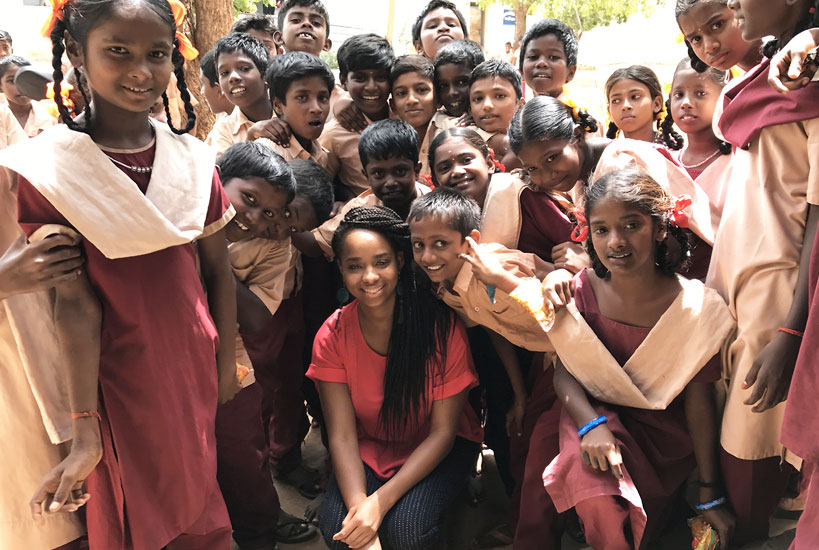Researching Human Rights Education Where Gandhi Pursued It

by Jamilah Pitts | Harlem Village Academy High School – New York, NY
As a product of urban schools and a first-generation college student, I have spent my professional career working to secure and foster better educational opportunities for students of color in urban schools. I have spent the past four years working as a high school English teacher in urban schools that serve mostly Latino students and students of African descent. This work is particularly challenging given the low literacy skills that student possess because of their disadvantaged backgrounds. Coming from a similarly impoverished community to that of my students, I do not pity them; rather, I recognize ways in which the lack of role models, poverty, substance abuse and trauma distract students from being able to prioritize school.
I have found solace in lessons and units, like youth participatory action research, human rights education, and social justice – projects that ignite within my students an impetus for learning that did not previously exist. For example, a rhetoric unit I designed this year allows students to apply the skills acquired in to persuade the school and outside community to take action against issues such as police brutality, gang violence, discrimination and bullying against the LGBTQ community and sex trafficking.
[minti_blockquote]To further this work, I designed my Fund for Teachers fellowship to work with People’s Watch India, an organization that works with a number of schools throughout the country on how to incorporate human rights education (HRE) in school environments, curricula, governance, and relationships.[/minti_blockquote]
I was particularly invested in carrying out this research in India because of the variety of human rights violations and social justice issues that exist in a democratic nation of this size. India, known for its cultural diversity, richness and beauty, is equally known for oppressive caste systems, racism, and discrimination against women and girls.
People’s Watch works with private (wealthy) and government (poorer schools) alike, and having the ability to study the ways in which this organization partners with schools, administrators and educators to design and implement a HRE program gave me the tools to replicate these practices into my school community.
I prepared for my fellowship by studying the work of Dr. Monisha Bajaj, an Indian-American scholar and professor in the HRE field who originally directed my to Amnesty International as an ideal research location. I then Skyped regularly with People Watch’s program director to learn about the organization’s logistics and program operations.
Upon my arrival in Bangalore, I spent the first week undergoing training that exposed me to policies and procedures before spending the remaining two weeks volunteering in two public schools. While Amnesty International operates under a “whole school approach” model that focuses on how to implement human rights into school governance, curriculum, relationships and environment, I focused primarily on gaining tools, resources, and practices around curriculum development.
India, like the United States, is plagued with disparity and inequality, so witnessing how Amnesty International works in schools to interrupt and eradicate existing social ills was invaluable. It is difficult to imagine being able to get an experience of this caliber elsewhere. I learned deeper ways to dive into literature in ways that not only expose the ills that plague characters in the societies in which they live, but also gained tools to do this work on a larger scale within my entire school community. Finally, as an educator who has multiple connections in the field of education (I am a freelance writer for Teaching Tolerance, for example, a member of the Woodrow Wilson Rockefeller Teaching Fellows, a UNCF Education Reform Fellow, and a member of the Institute for the Recruitment of Teachers) I am eager to share this work with other networks of educators who can benefit from the resources that I gained on my fellowship.
After observing implementation of an HRE human rights education in India, I am now teaching a new elective course designed to teach about human rights and how to preserve and promote them. Additionally, my literature students are being exposed to human rights violations and social justice issues through the study of global texts. In designing lessons and units, I am more intentional about incorporating mindfulness and aspects of human rights education into our classroom spaces and will continue to see curriculum, instruction and pedagogy as a means to deliver both content and a vehicle to shape and sharpen character. With my peers, I plan to share this work by inviting them into my classroom and identifying ways to collaborate so they are able to join this work. I also plan to continue writing about and publishing this work in spaces for educators on a broad spectrum. Perhaps most importantly, I will continue to seek out research, resources and ways to integrate larger altruistic beliefs and practices in the classroom.

[minti_divider style=”1″ icon=”” margin=”30px 0px 30px 0px”]
While much of Jamilah’s professional career as an educator has consisted of working with urban youth, she has also taught in the Dominican Republic and China. Jamilah is an avid traveler, dancer, and writer whose work is threaded by themes of social justice, and human and women’s rights advocacy.
 Back to Blogs
Back to Blogs